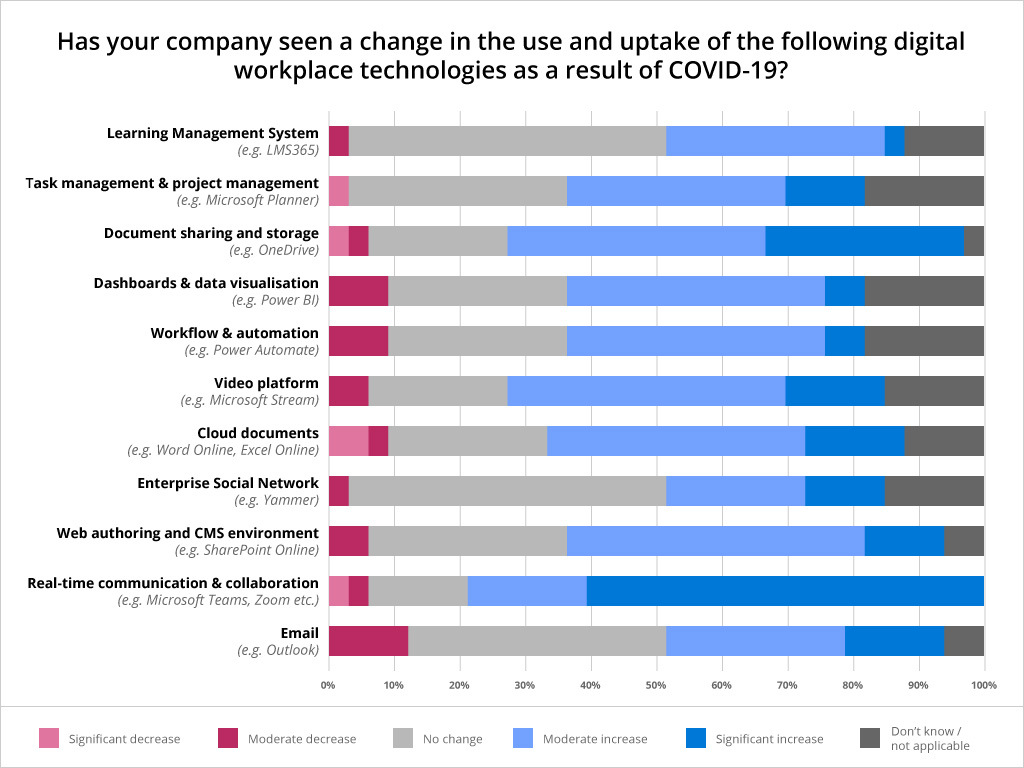You dont need us to tell you what a pivotal year 2020 has been for the digital workplace. Many organisations have found that the investment they have made in tools such as Microsoft Teams and platforms like Microsoft 365 have been critical for business continuity, as well as keeping employees informed during the COVID-19 pandemic.
This rapid acceleration of digital workplace maturity means that digital workplace teams will be starting 2021 in a very different way to 2020. The wider business and working climate will be very different, with the ongoing pandemic meaning a highly fragile economy and scaled-up patterns of hybrid working are set to continue.
With such a period of intense change, we were keen to understand in more detail how the events of 2020 impacted digital workplace teams in the tools that they use and how they see the future. We decided to run a survey called Digital Workplace Strategy 2021 that asked various questions with a range of multiple-choice and free text questions. We ran the survey for a few weeks in late 2020, and received responses from digital workplace professionals in nearly 60 organisations
Here are ten of the key takeaways from the survey.
1 The digital workplace is maturing
In the past, digital workplace surveys have suggested that the collective maturity of the digital workplace has been at a relatively early stage, although investment in Microsoft 365, collaboration tools and awareness of the digital workplace concept has seen some advancement.
Our survey suggests that one of the impacts of 2020 is a significant advance in the maturity of the digital workplace. 56% of organisations told us their digital workplace was either growing or fully embedded, and had reached maturity. Only 17% described their maturity level as basic or early. While we dont have a truly comparable set of data for 2019, our strong impression is that the needle has moved on maturity.
2 COVID-19 has changed the plans of digital workplace teams
With COVID-19 having a tangible effect on the digital workplace, it has also inevitably influenced the corresponding plans and intended roadmaps of digital workplace teams. In our survey, we asked about the extent of the impact of COVID-19 on digital workplace strategy; only 3% of respondents told us that COVID-19 had had no impact, while 64% said that the pandemic had changed strategy a little or moderately. A third told us it had changed their digital workplace strategy a lot or a great deal. The vast majority of digital workplace strategies have been shaped by COVID-19 in some way.
3 2020 digital workplace priorities are 2021 priorities
With the pandemic changing digital workplace plans, we wanted to understand how that might translate into strategies for 2021. Here, the priorities that proved important during 2020 as pillars of business continuity robust digital communication channels and support for remote working look set to continue in 2021. Nearly 80% of organisations told us digital communication and content was a very important priority, the most popular answer, while support and scale of remote working was very important for 57% of organisations. Other very important areas were digitisation and automation (60%) and employee onboarding (57%).
4 Investment in digital skills is critical
With more and more digital interactions required because of remote working, we believe investment in digital literacy and skills is going to be increasingly important, particularly as sections of the workforce who previously had less access to digital workplace tools start to drive more sophisticated usage. In our survey, 54% of respondents said that improving digital skills was very important for their organisation; we believe this will be a focus going forward.
5 Company culture has become more empathetic
COVID-19 hasnt just impacted the digital workplace, its also changed organisational culture. While there have been many anecdotes of support for employees and customers, alongside inspirational stories about people helping each other out, our survey suggests there has been a deeper impact on organisations.
64% of respondents told us COVID-19 had made their organisational culture more empathetic and supportive, while 17% told us there had been no change. Perhaps surprisingly, 19% said their organisation was less empathetic and supportive, possibly a reflection of difficult choices made in the face of very tough trading conditions.
6 Digital workplace budgets and teams are still largely intact
We wanted to ascertain the impact of COVID-19 on investment in digital workplace tools and teams. Despite the economic fallout of the pandemic, investment appears not to have suffered as much as we may have anticipated; possibly, this is a reflection of the value that the digital workplace has brought to business continuity.
When we asked whether budgets had been impacted by COVID-19, 31% said there had been no impact and 28% indicated that their budget had increased, while 25% said it had decreased. In terms of team size, 75% had seen no change, while the number indicating headcount had been reduced (14%) was partially offset by those who had actually seen an increase (11%). This is despite the fact that many of the organisations who participated in the survey had been negatively impacted by COVID-19 – nearly half of respondents reported an overall negative impact on business.
7 But budget constraints may bite in 2021
Although budget cuts to the digital workplace were less significant than one might expect, there was less confidence about what lies ahead. We asked respondents to pick their top three challenges for 2021 from a number of choices. Here, constrained budgets are expected to bite in 2021 with 51% of organisations declaring it a top challenge; continuing uncertainty due to COVID-19 was the joint second most popular answer (40%).
8 Adoption of other tools has piggy-backed off real-time communication success
Everyone knows about the massive uptake in the adoption of real-time communication and collaboration tools like Microsoft Teams and Zoom, but what about other tools? We asked respondents about how adoption of a range of tools had fared during the pandemic. Being a Microsoft consultancy, we used the Office 365 suite of tools as a basis for constructing the list of tools from which respondents could choose.
Here, we found an increase in adoption of digital workplace tools across the board, clearly piggy-backing off the scale-up of Teams and equivalent technologies. While respondents reported the biggest rise in adoption was for collaboration and communication tools, every other tool also enjoyed some kind of reported rise in adoption. Use of streaming video, cloud documents, cloud drives, and CMS (e.g. SharePoint) all saw large increases in adoption.
9 There are multiple opportunities to drive value in the digital workplace
In terms of levels of adoption of different tools, whilst many organisations reported moderate adoption of important tools such as video platforms (42%), workflow and automation tools (39%) and dashboard and data visualisation capabilities (33%), far fewer attributed significant adoption levels to these tools. We believe this indicates there are considerable opportunities to drive value in tools that have a real potential to initiate transformation, such as in automating processes at-scale or opening up data to aid decision-making for all employees.

10 Everyone has had a different journey
2020 has been a rollercoaster ride, and organisations have had wildly different experiences down to a variety of factors including size, sector, business line, workforce demographics and the level of digital workplace maturity before the pandemic struck. The range of different journeys were evident in the variety of responses we got when we asked for any additional comments.
Some organisations had not been impacted greatly; in fact, one reported the biggest outcome was not having an in-person conference. For others, it has a been a harder journey – one respondent told us We were behind the curve and are still catching up. Other answers reflected on the factors that had made a difference, including the importance of digital workplace strategy.
Whats your digital workplace strategy?
Its clear that COVID-19 has had a profound impact on everything from digital workplace adoption through to organisational culture. The survey has provided some fascinating insights into digital workplace trends and the strategies that different teams are following. How has your digital workplace strategy been impacted? If youd like to discuss any of the results of the survey or the next steps for your digital workplace, then get in touch!
 And the winner is…We promised to run a prize draw to win £100 of Amazon vouchers for people who completed the survey. The winner is from The Specialist Works.
And the winner is…We promised to run a prize draw to win £100 of Amazon vouchers for people who completed the survey. The winner is from The Specialist Works.



 SharePoint Products
SharePoint Products

